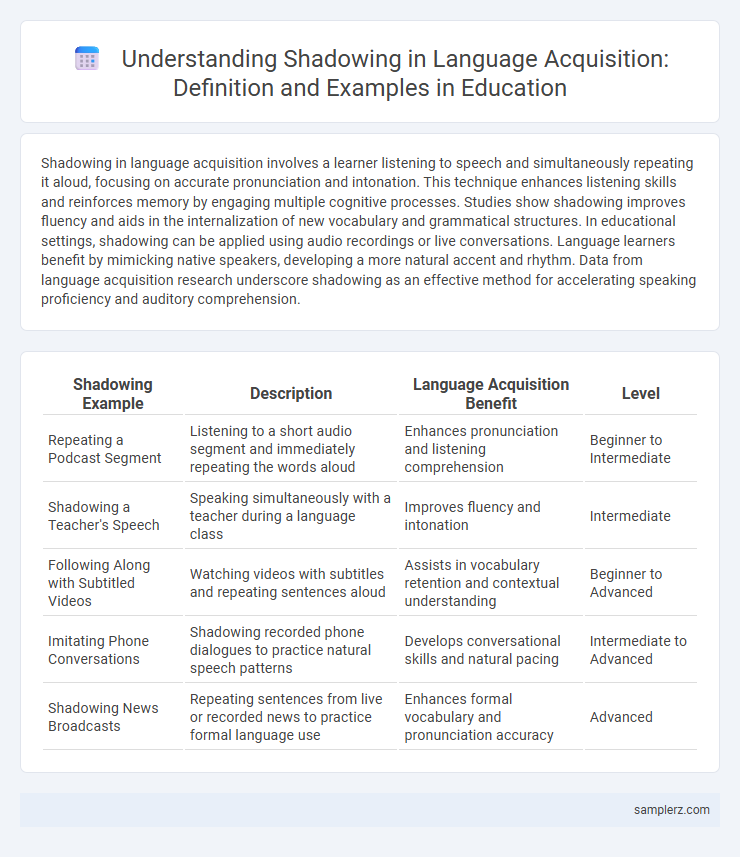Shadowing in language acquisition involves a learner listening to speech and simultaneously repeating it aloud, focusing on accurate pronunciation and intonation. This technique enhances listening skills and reinforces memory by engaging multiple cognitive processes. Studies show shadowing improves fluency and aids in the internalization of new vocabulary and grammatical structures. In educational settings, shadowing can be applied using audio recordings or live conversations. Language learners benefit by mimicking native speakers, developing a more natural accent and rhythm. Data from language acquisition research underscore shadowing as an effective method for accelerating speaking proficiency and auditory comprehension.
Table of Comparison
| Shadowing Example | Description | Language Acquisition Benefit | Level |
|---|---|---|---|
| Repeating a Podcast Segment | Listening to a short audio segment and immediately repeating the words aloud | Enhances pronunciation and listening comprehension | Beginner to Intermediate |
| Shadowing a Teacher's Speech | Speaking simultaneously with a teacher during a language class | Improves fluency and intonation | Intermediate |
| Following Along with Subtitled Videos | Watching videos with subtitles and repeating sentences aloud | Assists in vocabulary retention and contextual understanding | Beginner to Advanced |
| Imitating Phone Conversations | Shadowing recorded phone dialogues to practice natural speech patterns | Develops conversational skills and natural pacing | Intermediate to Advanced |
| Shadowing News Broadcasts | Repeating sentences from live or recorded news to practice formal language use | Enhances formal vocabulary and pronunciation accuracy | Advanced |
Understanding Shadowing in Language Acquisition
Shadowing in language acquisition involves listening to spoken language and simultaneously repeating it to improve pronunciation, intonation, and fluency. This technique enhances auditory processing and reinforces neural connections for language comprehension and speech production. Research indicates that consistent shadowing practice accelerates vocabulary retention and promotes natural speaking rhythms.
Key Benefits of Shadowing for Language Learners
Shadowing in language acquisition involves learners immediately repeating spoken language to enhance pronunciation, intonation, and fluency. This technique improves listening comprehension by training the brain to process natural speech patterns and increases speaking confidence through active engagement. Research shows that consistent shadowing accelerates vocabulary retention and helps internalize grammatical structures in context.
Practical Examples of Shadowing Techniques
Shadowing in language acquisition involves learners listening to a native speaker and simultaneously repeating what is heard, improving pronunciation and fluency through immediate vocal imitation. Practical examples include using audio recordings of dialogues or speeches where learners mimic intonation and rhythm in real-time, enhancing auditory processing and speaking skills. Shadowing apps and language labs often incorporate timed pauses and repetition exercises to reinforce memory retention and accelerate verbal proficiency.
Shadowing with Native Speaker Audio Resources
Shadowing with native speaker audio resources involves learners listening to and simultaneously repeating spoken language from authentic recordings, enhancing pronunciation, intonation, and fluency. Utilizing podcasts, audiobooks, or language learning apps featuring native speakers helps learners internalize natural speech patterns and improve auditory comprehension. This method accelerates language acquisition by promoting active engagement with the target language in real-time contexts.
Implementing Shadowing in the Classroom
Implementing shadowing in the classroom involves students listening to authentic audio recordings and simultaneously repeating the spoken language to improve pronunciation, intonation, and fluency. Teachers can use dialogues, podcasts, or language apps tailored to the learners' proficiency levels, facilitating real-time practice and immediate correction. Shadowing fosters active listening skills and enhances language acquisition by mimicking natural speech patterns in immersive, controlled environments.
Shadowing Activities for Improving Pronunciation
Shadowing activities involve learners listening to native speakers and immediately repeating their speech to improve pronunciation, rhythm, and intonation. This technique enhances phonological awareness by synchronizing auditory perception with vocal reproduction, leading to more accurate and natural-sounding speech. Consistent practice with shadowing fosters better accent imitation and increases fluency in the target language.
Shadowing in One-on-One Tutoring Sessions
Shadowing in one-on-one tutoring sessions involves students listening to a fluent speaker and simultaneously repeating words or sentences, enhancing pronunciation and intonation mastery. This method accelerates language acquisition by improving auditory processing and speaking confidence through immediate feedback. Personalized interaction in tutoring optimizes shadowing effectiveness by tailoring difficulty and correcting errors in real-time.
Technology Tools for Effective Shadowing Practice
Digital platforms like FluentU and Shadowing Pro provide interactive videos and real-time transcription, enhancing language learners' shadowing practice by improving pronunciation and intonation accuracy. Mobile apps equipped with speech recognition technology offer immediate feedback, enabling users to self-correct and develop fluent speaking skills efficiently. Integrating these technology tools into shadowing routines accelerates language acquisition and increases learner engagement through personalized, adaptive learning experiences.
Shadowing for Vocabulary and Comprehension Enhancement
Shadowing in language acquisition involves learners immediately repeating spoken words or sentences to enhance vocabulary retention and boost comprehension skills. This technique improves the ability to recognize and internalize new words in context, facilitating faster language processing. Consistent practice with shadowing strengthens auditory discrimination and reinforces memory, making it a vital strategy for language learners seeking vocabulary expansion and deeper understanding.
Case Studies: Success Stories in Shadowing for Language Learning
Case studies in shadowing for language acquisition reveal significant improvements in pronunciation, fluency, and listening comprehension among learners of Spanish and Mandarin. One notable example includes a group of adult learners who practiced shadowing daily with native speaker audio materials, resulting in a 30% increase in oral proficiency scores within three months. These success stories underscore the effectiveness of shadowing as a practical technique for enhancing real-time language processing and speaking confidence.

example of shadowing in language acquisition Infographic
 samplerz.com
samplerz.com